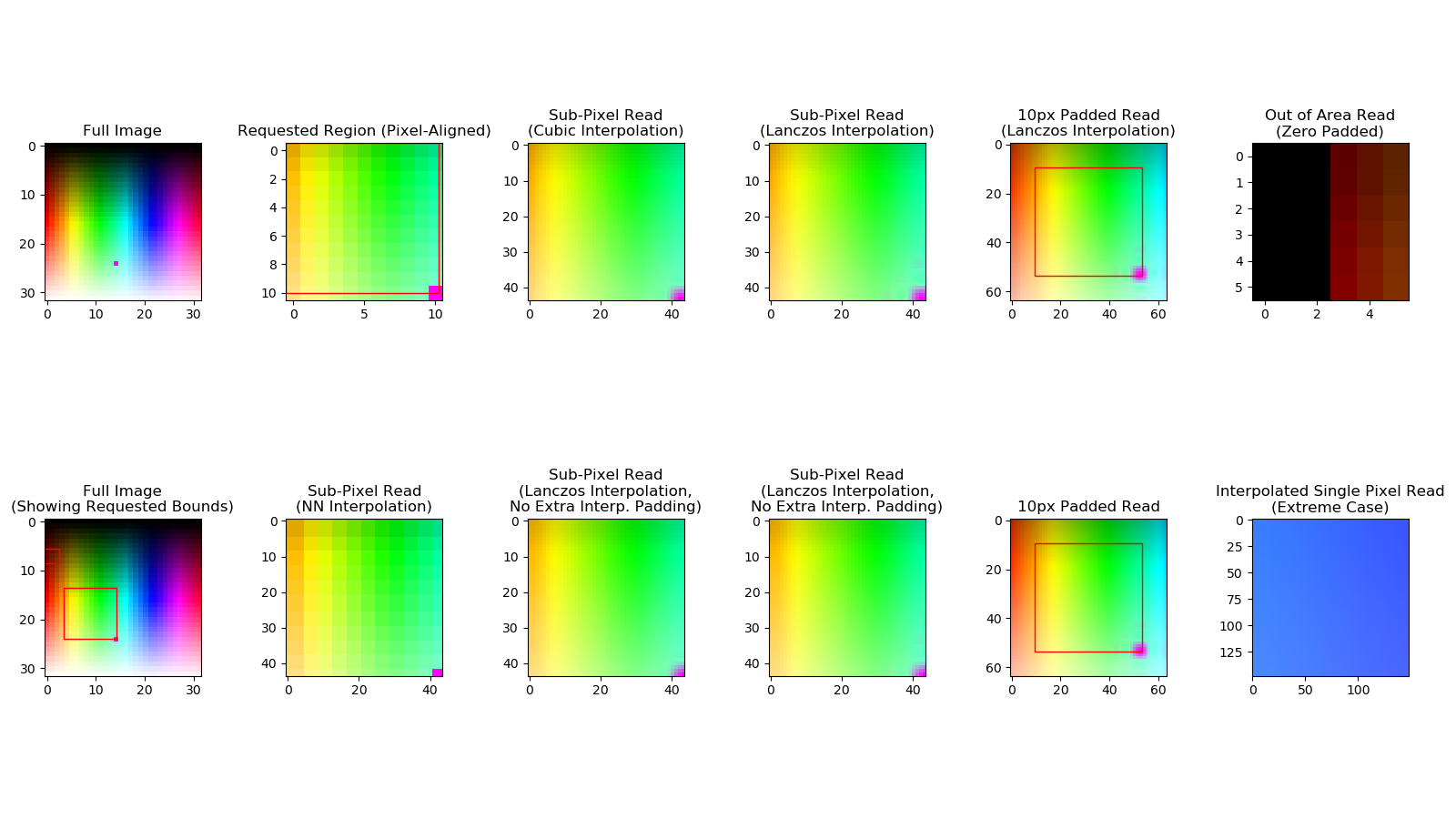sub_pixel_read¶
tiatoolbox.utils.image.sub_pixel_read
- sub_pixel_read(image, bounds, output_size, padding=0, stride=1, interpolation='nearest', interpolation_padding=2, read_func=None, pad_mode='constant', pad_constant_values=0, read_kwargs=None, pad_kwargs=None, *, pad_at_baseline)[source]¶
Read and resize an image region with sub-pixel bounds.
Allows for reading of image regions with sub-pixel coordinates, and out of bounds reads with various padding and interpolation modes.

- Parameters:
image (
numpy.ndarray) – Image to read from.bounds (tuple(float)) – Bounds of the image to read in (left, top, right, bottom) format.
padding (int or tuple(int)) – Amount of padding to apply to the image region in pixels. Defaults to 0.
stride (int or tuple(int)) – Stride when reading from img. Defaults to 1. A tuple is interpreted as stride in x and y (axis 1 and 0 respectively).
interpolation (str) – Method of interpolation. Possible values are: nearest, linear, cubic, lanczos, area. Defaults to nearest.
pad_at_baseline (bool) – Apply padding in terms of baseline pixels. Defaults to False, meaning padding is added to the output image size in pixels.
interpolation_padding (int) – Padding to temporarily apply before rescaling to avoid border effects. Defaults to 2.
read_func (collections.abc.Callable) – Custom read function. Defaults to
safe_padded_read(). A function which recieves two positional args of the image object and a set of integer bounds in addition to padding key word arguments for reading a pixel-aligned bounding region. This function should return a numpy array with 2 or 3 dimensions. See examples for more.pad_mode (str) – Method for padding when reading areas are outside the input image. Default is constant (0 padding). This is passed to read_func which defaults to
safe_padded_read(). Seesafe_padded_read()for supported pad modes. Setting to “none” or None will result in no padding being applied.pad_constant_values (int, tuple(int)) – Constant values to use when padding with constant pad mode. Passed to the
numpy.pad()constant_values argument. Default is 0.read_kwargs (dict) – Arbitrary keyword arguments passed through to read_func.
pad_kwargs (dict) – Arbitrary keyword arguments passed through to the padding function
numpy.pad().
- Returns:
Output image region.
- Return type:
numpy.ndimage- Raises:
ValueError – Invalid arguments.
AssertionError – Internal errors, possibly due to invalid values.
Examples
>>> # Simple read >>> bounds = (0, 0, 10.5, 10.5) >>> sub_pixel_read(image, bounds, pad_at_baseline=False)
>>> # Read with padding applied to bounds before reading: >>> bounds = (0, 0, 10.5, 10.5) >>> region = sub_pixel_read( ... image, ... bounds, ... padding=2, ... pad_mode="reflect", ... pad_at_baseline=False, ... )
>>> # Read with padding applied after reading: >>> bounds = (0, 0, 10.5, 10.5) >>> region = sub_pixel_read(image, bounds, pad_at_baseline=False) >>> region = np.pad(region, padding=2, mode="reflect")
>>> # Custom read function which generates a diagonal gradient: >>> bounds = (0, 0, 10.5, 10.5) >>> def gradient(_, b, **kw): ... width, height = (b[2] - b[0], b[3] - b[1]) ... return np.mgrid[:height, :width].sum(0) >>> sub_pixel_read(bounds, read_func=gradient, pad_at_baseline=False)
>>> # Custom read function which gets pixel data from a custom object: >>> bounds = (0, 0, 10, 10) >>> def openslide_read(image, bounds, **kwargs): ... # Note that bounds may contain negative integers ... left, top, right, bottom = bounds ... size = (right - left, bottom - top) ... pil_img = image.read_region((left, top), level=0, size=size) ... return np.array(pil_img.convert("RGB")) >>> sub_pixel_read(bounds, read_func=openslide_read, pad_at_baseline=False)